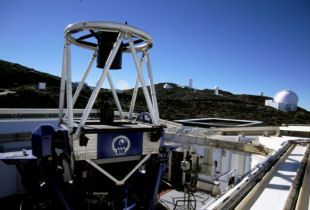Nov 30 2013
As part of an international team of astrophysicists working with a trio of NASA satellites , the Liverpool Gamma Ray Burst team at LJMU’s Astrophysics Research Institute are helping to unravel the mysteries of the most powerful cosmic explosions in the universe - Gamma Ray Bursts (GRB).
 LJMU's robotic telescope
LJMU's robotic telescope
Using the world's largest autonomous robotic telescopes - the 2-m Liverpool Telescope and Faulkes Telescope - the Liverpool GRB team captured never-before-seen details of an event that challenges current theoretical understanding of how gamma-ray bursts work.
They caught the light from the dying embers of a newly born black hole, formed in the spectacular explosion of a massive star and named GRB 130427A - the brightest GRB detected in the past 29 years. Just minutes after NASA's Swift satellite identified the high energy gamma rays from the explosion and beamed down the sky location, the Faulkes Telescope North in Hawaii swung into action and used the Liverpool team's sophisticated automatic software to find the optical counterpart.
In concert with NASA's Swift, Fermi and NuSTAR satellites the Liverpool team's data are revolutionising understanding of the most power explosions in the Universe and, in particular, GRB 130427A which lies at a distance of only 3.8 billion light years - considered by astronomers to be next door compared to the vast cosmic distances usually measured for GRBs.
Professor Carole Mundell, leader of the Liverpool GRB team said:
"As soon as NASA's Swift satellite discovered the gamma rays from this monster, our giant robotic telescopes began to automatically take multicolour photos of it."
Using the Faulkes and Liverpool Telescopes, the team continued to measure the fading for the next two and a half weeks, providing remarkable coverage of the burst's evolution.
" Within minutes, we knew it was very bright so it was a shock to then discover how near it was." said Professor Mundell. "The small number of nearby GRBs that have been discovered have all been shown to be weak counterparts to their more powerful cousins in the distant universe. GRB 130427A is the first full-power GRB to be found so nearby."
Dr Shiho Kobayashi, leader of ARI's GRB theory group added:
"These data cover an unprecedented range of energies and timescales and are may changing our models of how and where these powerful explosions can occur. We may have to revise our understanding of relativistic shock physics to explain the late-time optical to gamma-ray emission."
"We expect to see an event like this once every century, so we're fortunate that it happened when we had a large array of sensitive space telescopes with complementary capabilities available to see it," said Paul Hertz, director of NASA's astrophysics division at NASA headquarters in Washington.
GRB 130427A is the subject of five papers published online Nov. 21. Four of these, published by Science Express, highlight contributions by Fermi and Swift satellites and ground-based RAPTOR, Liverpool and Faulkes telescopes. The NuSTAR study is published by The Astrophysical Journal Letters. The Liverpool GRB team are involved in Maselli et al. Science and Kouveliotou et al. Astrophysical Journal Letters
The Science Express paper: GRB 130427A: A Nearby Ordinary Monster
http://www.sciencemag.org/content/early/2013/11/20/science.1242279.abstract
The Astrophysical Journal Letters paper: http://iopscience.iop.org/2041-8205/779/1/L1/article
What are Gamma Ray Bursts?
Gamma Ray Bursts are the most luminous explosions in the cosmos. Astronomers think most occur when the core of a massive star runs out of nuclear fuel, collapses under its own weight, and forms a black hole. The black hole then drives jets of particles that drill all the way through the collapsing star and into space at nearly the speed of light. They are the highest energy form of light. Hot matter surrounding the baby black hole and internal shock waves produced by collisions within the jet are thought to emit gamma rays with energies in the million-electron-volt (MeV) range, or roughly 500,000 times the energy of visible light. The highest-energy emission, with billion electron volt (GeV) gamma rays, is believed to arise when the jet slams into its surroundings, forming an external shock wave.
Jet Shockwaves Produce Gamma Rays https://www.youtube.com/watch?v=BuMCP4pQvhY